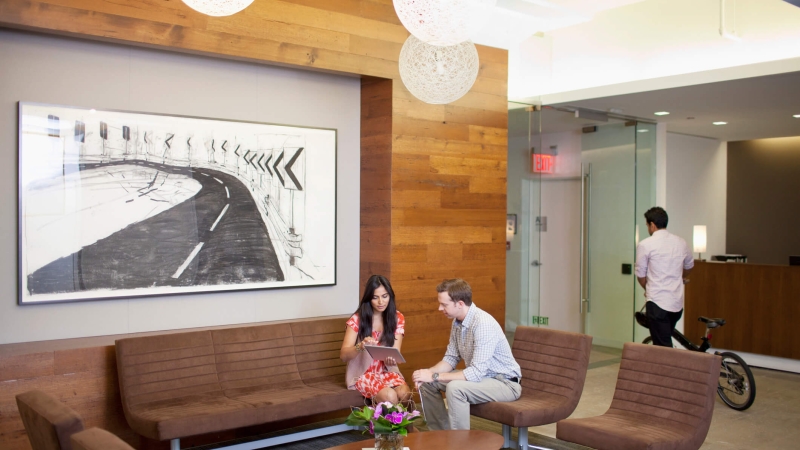Turning form and function into a cohesive and attractive lobby design can be challenging, and finding small hotel lobby design ideas that look good and make sense can be even more complicated. Whether you are brand new to the hospitality industry, facing the challenge of decorating a fun-sized lobby for the first time, or a seasoned hotelier seeking fresh, unique, and captivating small lobby design ideas, you’ve come to the right place.
In this post, we discuss the unique challenges faced by hotels, motels, and other lodging partners with small lobbies. We provide inspiring tips and creative ideas for overcoming the constraints of small areas to help you make the most of your space. Whether you’re preparing for full-property renovations or looking for small hotel lobby design ideas to spruce up your area, we can help!
Small hotel lobby design ideas with big time appeal
A hotel’s lobby provides guests and travelers with a common place to gather. Often stocked with coffee, newspapers, and other amenities, it’s a place to find hospitality. They are welcoming spaces where arriving, departing, and in-house guests can relax, mingle, check email, purchase sundry items, and more. However, a lobby inside a hotel with real heart—no matter its size—is so much more than a place to access Wi-Fi or grab a quick bite on your way out the door.
Why is a hotel’s lobby so important?
Upon arriving at your hotel, the hotel lobby is one of the first things guests experience. It is where guests first encounter the sights, smells, sounds, and staff, which can significantly impact how travelers perceive your property.
Hotel first impressions are important; they set the stage for the upcoming stay—whether it will be quiet and relaxing, tech and work-friendly, or spirited and communal. A positive first encounter with a hotel’s lobby sets the tone for everything to come, just as a negative first hotel lobby encounter can leave any traveler with a poor (and lasting) impression.
How large is a “small” hotel lobby?
Like the buildings they reside in, hotel lobbies come in many shapes and sizes, and they tend to be larger than office lobbies and reception areas. For comfort, form, and functionality, even the smallest hotel lobbies typically provide at least 36 square feet of space, measuring no less than 6’ x 6’.
With so many sizes and styles of hotels worldwide, some lobbies are ostensible and ornate. However, traditionally “large” hotel lobbies offer closer to 120 square feet of communal space. Considering smaller lobbies are only about a quarter the size of their larger hotel counterparts, creating an attractive and accommodating design for a smaller space isn’t always easy.
The fundamentals of designing a small hotel lobby
Before delving into lobby design and decoration ideas, it’s important to consider the primary functional and architectural elements that will impact the space’s overall quality. Maximize minimal lobby space by strategic decisions regarding:
- The lobby layout and floor plan
The flow and layout of the lobby should be at the center of your design ideas. Create a hotel floor plan designed to keep traffic moving through the lobby. Avoid impeding entrances, hallways, or other major passages with furniture or significant tech installations.
- Strategically placed service stations
From shared guest amenities and communal spaces, like a coffee bar or business center, to functional hotel operational stations, like the actual front desk, thoughtfully plan how to maximize every inch of your hotel’s available lobby space.
- Guest circulation spaces
When designing small hotel lobbies, it’s particularly important to include enough space around delicate furnishings, artwork, and fragile decor to provide guests with room to move comfortably without running into or damaging property. In interior design, this empty area is called circulation space.
Stay on top of 2024's hotel marketing trends
Small hotel lobby design ideas and decoration tips
In addition to the lobby's floor plan, layout, and structural design, its décor and stylistic design affect how large the room feels and how it makes your guests feel. Even if your space is small, you can still make travelers feel at home with these design ideas and decoration tips.
- Pair form and function
Consider selecting furniture that is both functional and fashionable. For example, tucking a couple of small, decorative ottomans below a writing table or small computer desk is a fantastic way to provide guests with functional, flexible sitting space while adding a dash of color and class.
- Take advantage of hotel architecture
Use your hotel’s unique shape, style, and architecture in your lobby design. Take advantage of recessed furniture, like recessed wall shelves or built-in bookshelves. Decorate fireplace mantels with local art, turn ledges into guest information stations, and find creative ways to work with what’s already in place.
Add accent pieces, colorful art, or simple décor to spruce up simple lobby spaces. Don’t be afraid to embrace minimalism in your design, but don’t forget to promote your brand either.
- Keep color and textures in mind
Color can significantly change how large a lobby looks and feels. For example, dark colors tend to make rooms look smaller, while neutral colors can help smaller spaces feel more open. Light and neutral tones that can help a small hotel lobby feel larger include:
• Crisp white
• Off-white or Eggshell
• Sea green
• Pale blue tones
Satin finishes can also help expand the feeling of the lobby, as they reflect light and create the appearance of additional space. Play with assorted colors and textures in your interior design.
- Create a sensory experience
Guests’ senses engage the moment they enter the lobby as they take in the sights and smells around them. Create a sensory guest experience with ambient lighting, living foliage, or comforting scents. Use sensory elements to create a scene or evoke an emotion that guests can form a memorable connection with.
- Choose the right music
Sound plays a key role in the general atmosphere of a hotel’s lobby. Even if you don’t always notice it, you’ll typically hear soft music playing in the hotel lobby, dining area, or elevators. While some properties opt for instrumental, others play their own hotel radio station in the background. Consider the acoustics of your space when deciding which type of music to play.
- Account for acoustics
Do the acoustics of the lobby spaces soften or heighten noises? Does it deafen loud music or amplify soft sounds? A room with high reverberations could cause even the lightest music to echo throughout the property, disturbing hotel guests as they sleep.
Consider placing soft furnishing or heavy carpeting around first-floor rooms and quiet public spaces to diffuse excess noise. You may also install noise control materials into the hotel’s wall coverings or flooring.
- Add digital entertainment
Lobby entertainment is a principal factor to consider in your overall design, and while music is important, good lobby design goes well beyond playing soft background music. Think of creative and entertaining ways to amuse travelers in limited space. Utilize hotel digital signage like colorful displays or an LED video wall; just be sure not to place entrancing tech in an area where a gathering crowd could impede traffic.
Learn from the best hotels in the business
Using hotel technology to supersize small lobby spaces
Make the most of your hotel lobby’s small design with digital transformation ideas that help optimize efficiency, improve the guest experience, and keep travelers moving through the tight space. Invest in creative and innovative hotel technology solutions, including:
- Interactive digital kiosks
Install an interactive digital kiosk that serves as an added team member and guest concierge. Program your property’s digital lobby kiosk to engage with guests and display valuable information they mind find helpful, including:
o Renovation updates
o Meeting and event timelines
o Traffic conditions
o Current weather conditions
o Daily food and beverage highlights
o Local attractions
o Exciting area events
- Digital room keys
Allow guests to bypass the front desk and go straight to their rooms with hotel mobile check-in. Using your hotel mobile app and their smartphone, tablet, or another device as a room key, travelers can head straight to their room upon arrival, swipe their device in front of the keypad, and settle in.
- Touchscreen menus
If you have an onsite restaurant but little lobby square footage where guests can wait for takeout, consider installing a contact-free touchscreen menu to make the best use of your space. In an alcove or small area inside the restaurant’s reception space, set up a pickup station where guests can grab their order when it’s ready to go. Set up a notification system in the hotel’s mobile app that allows guests to track their order—much like using DoorDash or UberEATS pickup service (without the excess fees, of course).
- In-room guest tablets
If you’re unable to install a touchscreen in the lobby, consider investing in in-room hotel tablets that enable guests to place to-go and room service orders, and track their status, all from the comfort of their guestroom.
- Strong, reliable Wi-Fi
Hotels facing a lack of open space and poor Wi-Fi run the risk of elevated levels of lobby congestion during peak traffic times, like check-in or checkout. Strong Wi-Fi throughout the hotel, especially in guestrooms and communal hotel facilities (e.g., fitness center and meeting rooms), helps prevent guests from lingering in the lobby while trying to land a strong internet connection. Help prevent overcrowding by securing the strongest hotel Wi-Fi available for planners, clients, and business travelers.
Make the most of other hotel spaces
Make other communal areas of the hotel, like the dining room or outdoor patio, as open and accessible as possible. This will help create inviting spaces for guests to enjoy, directing them away from the lobby, reducing bottle-neck situations, and minimizing long lines.
Put these small hotel lobby design ideas to good use!
Now that you know how much potential a small hotel lobby can have, let’s look at other ways design can affect your property. From finding your focus to blending in with your surroundings, we’ll show you everything you need about hotel interior design.






